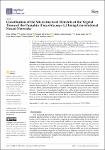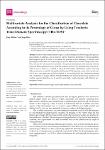Dielectric spectral profiles for andean tubers classification: a machine learning techniques application
| dc.contributor.author | Chuquizuta Trigoso, Tony | |
| dc.contributor.author | Oblitas Cruz, Jimy | |
| dc.contributor.author | Arteaga Miñano, Hubert | |
| dc.contributor.author | Yarleque, Manuel | |
| dc.contributor.author | Castro Silupu, Wilson | |
| dc.date.accessioned | 2022-08-09T20:28:25Z | |
| dc.date.available | 2022-08-09T20:28:25Z | |
| dc.date.issued | 2021-09-21 | |
| dc.identifier.citation | Chuqizuta, T., ...[et al.]. (2021). Dielectric spectral profiles for andean tubers classification: a machine learning techniques application. 2021 International Conference on Electromagnetics in Advanced Applications, ICEAA. http://dx.doi.org/10.1109/ICEAA52647.2021.9539623 | es_PE |
| dc.identifier.uri | https://hdl.handle.net/11537/31119 | |
| dc.description | El texto completo de este trabajo no está disponible en el Repositorio Académico UPN por restricciones de la casa editorial donde ha sido publicado. | es_PE |
| dc.description.abstract | Currently, the agri-food industry prioritizes the development of non-destructive methods, such as dielectric spectroscopy, for quality control. The obtained dielectric spectral properties can be coupled to multivariate statistical methods as "machine learning" when identification of attributes is wanted. However, these techniques have not been applied to andean tubers classification. Therefore, the objective of the present investigation is to evaluate the possibility of discriminating four andean tubers using dielectric spectra properties and machine learning techniques (Support Vector Machine - SVM, K-Nearest Neighbors-KNN, and Linear Discriminat - LD). For this purpose, samples of Tropaeolum tuberosum (Killu isañu), Solanum tuberosa (yellow) and two varieties of Oxalis tuberosa (Puka kamusa and Lari oqa) were acquired, 30 units per tuber. The dielectric spectral profile was extracted twice for each tubers sample, in the range from 2 to 8 GHz. Then, the dielectric constant (e') were calculated, and its dimensionality was reduced using principal component analysis. Finally, models for classification were built by employing KNN, SVM and LD techniques. The results showed that three components can explain the variance at 99.6 %. Likewise, the accuracy in the discrimination values varied between 79.17 - 83.04, being SVM the best discrimination technique. Consequently, it is concluded that the technique of dielectric spectroscopy and machine learning presents potential for andean tuber discrimination. | es_PE |
| dc.format | application/pdf | es_PE |
| dc.language.iso | eng | es_PE |
| dc.publisher | IEEE | es_PE |
| dc.rights | info:eu-repo/semantics/closedAccess | es_PE |
| dc.source | Universidad Privada del Norte | es_PE |
| dc.source | Repositorio Institucional - UPN | es_PE |
| dc.subject | Espectroscopia | es_PE |
| dc.subject | Productos agrícolas | es_PE |
| dc.subject | Tubérculos | es_PE |
| dc.subject | Control de calidad | es_PE |
| dc.subject | Industria | es_PE |
| dc.subject | Spectroscopy | es_PE |
| dc.subject | Quality control | es_PE |
| dc.subject | Andean tubers | es_PE |
| dc.title | Dielectric spectral profiles for andean tubers classification: a machine learning techniques application | es_PE |
| dc.type | info:eu-repo/semantics/conferenceObject | es_PE |
| dc.publisher.country | US | es_PE |
| dc.identifier.journal | 2021 International Conference on Electromagnetics in Advanced Applications, ICEAA | es_PE |
| dc.description.peer-review | Revisión por pares | es_PE |
| dc.subject.ocde | https://purl.org/pe-repo/ocde/ford#2.11.04 | es_PE |
| dc.description.sede | Cajamarca | es_PE |
| dc.identifier.doi | http://dx.doi.org/10.1109/ICEAA52647.2021.9539623 |
Files in this item
| Files | Size | Format | View |
|---|---|---|---|
|
There are no files associated with this item. |
|||




